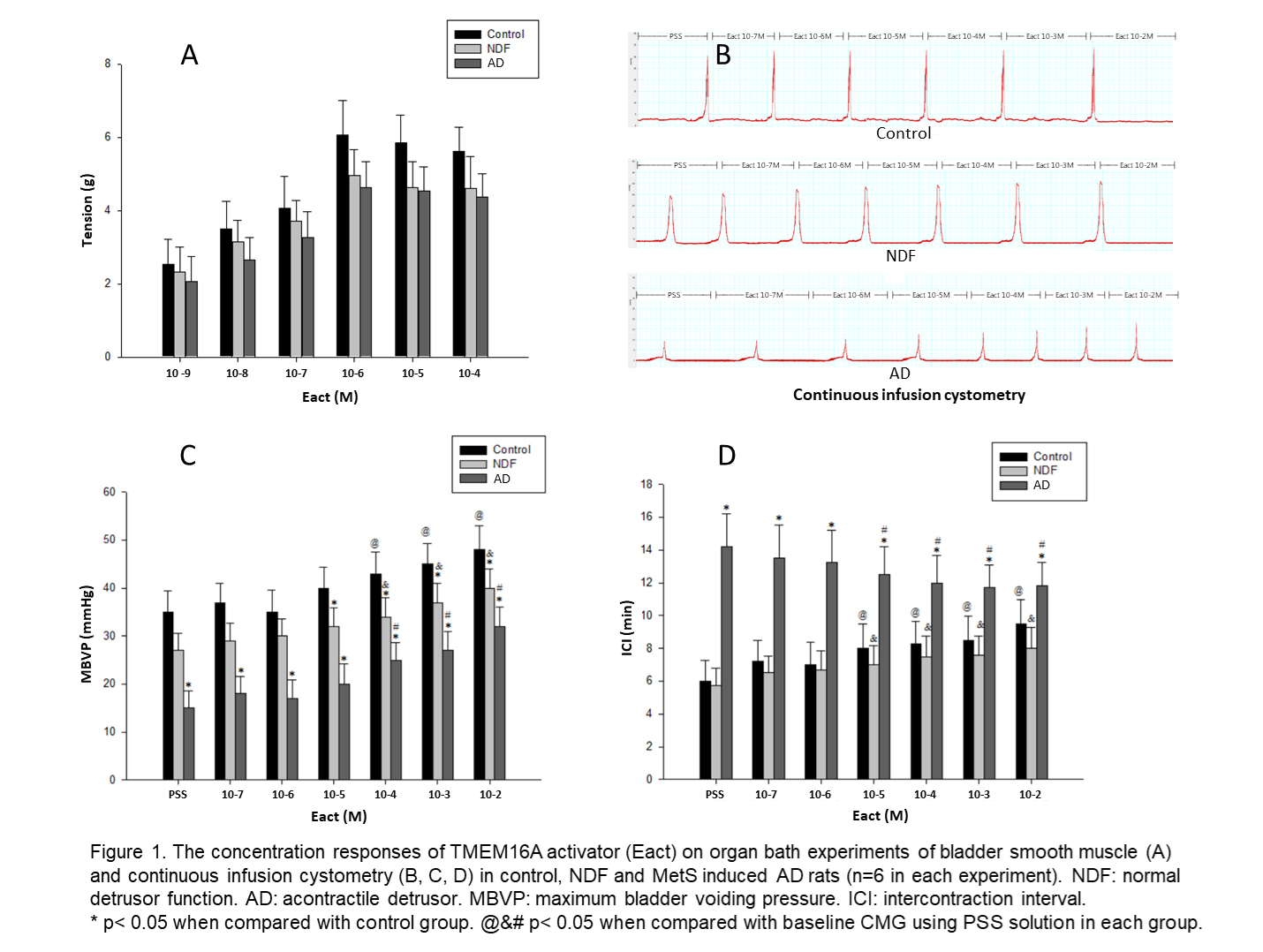Back
Poster, Podium & Video Sessions
Moderated Poster
MP07: Bladder & Urethra: Anatomy, Physiology & Pharmacology
MP07-15: The effects of TMEM16A chloride channel activator on cystometry in rats with metabolic syndrome induced acontractile detrusor
Friday, May 13, 2022
10:30 AM – 11:45 AM
Location: Room 228
Yuh-Chen Kuo, Cheng-An Kuo*, Hong-Chiang Chang, Ju-Ton Hsieh, Taipei, Taiwan
- CK
Poster Presenter(s)
Introduction: The pharmacotherapy for acontractile detrusor (AD) is still disappointing. Previous studies have demonstrated the functional role of calcium activated chloride channel (CaCC) on bladder smooth muscle. We investigated the effects of activation of TMEM16A, a CaCC, on detrusor strips and voiding cycle presented in cystometry (CMG) using a model of metabolic syndrome (MetS) induced AD in rats.
Methods: Fructose feeding rats were fed a fructose rich diet while control animals received standard rat chow for 6 months. Based on the results of cystometric presentation at month 6, rats in NDF group (normal detrusor function) and AD group were selected. We conducted a strategy using a TMEM16A activator (N-(2-methoxyethyl)-N-(4-phenyl-2-thiazolyl)- 2,3,4-trimethoxybenzeneacetamide (Eact )) as reagent to involve ?Organ bath isometric tension experiments of harvested bladder smooth tissue to construct concentration-response curve (CRC). ?Continuous infusion CMG under anesthesia with replacement of infused physiological saline by Eact solution at different concentrations. The results of CRC and the CMG parameters including maximum bladder voiding pressure (MBVP) and intercontraction interval (ICI) were recorded and compared among control, NDF and AD groups.
Results: ?Administration of Eact could induce contractions on isolated rat detrusor in control, NDF, and AD groups. The tension increased as the concentration of Eact increased (Figure 1A). The ED80 for Eact was 1.7x10-5M. ?The reduced MBVP in AD group could be significantly potentiated by intravesical treatment of Eact (?1X10-4M) in a concentration dependent manner. The MBVP in NDF and control groups could also be significantly enhanced by intravesical treatment of Eact (both ?1X10-4M) (Figure 1C). The prolonged ICI in UAB group could be significantly shortened by intravesical treatment of Eact (?1X10-5M) in a concentration dependent manner while the ICI in NDF and control groups could be significantly lengthened (Figure 1D).
Conclusions: This study demonstrated activation of TMEM16A CaCC can “reverse” the decreased voiding pressure and prolonged intercontraction interval of cystometry in rats with MetS induced AD, indicating the novel therapeutic target of TMEM16A CaCC for AD.
Source of Funding: Department of Health, Taipei City Government

Methods: Fructose feeding rats were fed a fructose rich diet while control animals received standard rat chow for 6 months. Based on the results of cystometric presentation at month 6, rats in NDF group (normal detrusor function) and AD group were selected. We conducted a strategy using a TMEM16A activator (N-(2-methoxyethyl)-N-(4-phenyl-2-thiazolyl)- 2,3,4-trimethoxybenzeneacetamide (Eact )) as reagent to involve ?Organ bath isometric tension experiments of harvested bladder smooth tissue to construct concentration-response curve (CRC). ?Continuous infusion CMG under anesthesia with replacement of infused physiological saline by Eact solution at different concentrations. The results of CRC and the CMG parameters including maximum bladder voiding pressure (MBVP) and intercontraction interval (ICI) were recorded and compared among control, NDF and AD groups.
Results: ?Administration of Eact could induce contractions on isolated rat detrusor in control, NDF, and AD groups. The tension increased as the concentration of Eact increased (Figure 1A). The ED80 for Eact was 1.7x10-5M. ?The reduced MBVP in AD group could be significantly potentiated by intravesical treatment of Eact (?1X10-4M) in a concentration dependent manner. The MBVP in NDF and control groups could also be significantly enhanced by intravesical treatment of Eact (both ?1X10-4M) (Figure 1C). The prolonged ICI in UAB group could be significantly shortened by intravesical treatment of Eact (?1X10-5M) in a concentration dependent manner while the ICI in NDF and control groups could be significantly lengthened (Figure 1D).
Conclusions: This study demonstrated activation of TMEM16A CaCC can “reverse” the decreased voiding pressure and prolonged intercontraction interval of cystometry in rats with MetS induced AD, indicating the novel therapeutic target of TMEM16A CaCC for AD.
Source of Funding: Department of Health, Taipei City Government


.jpg)
.jpg)